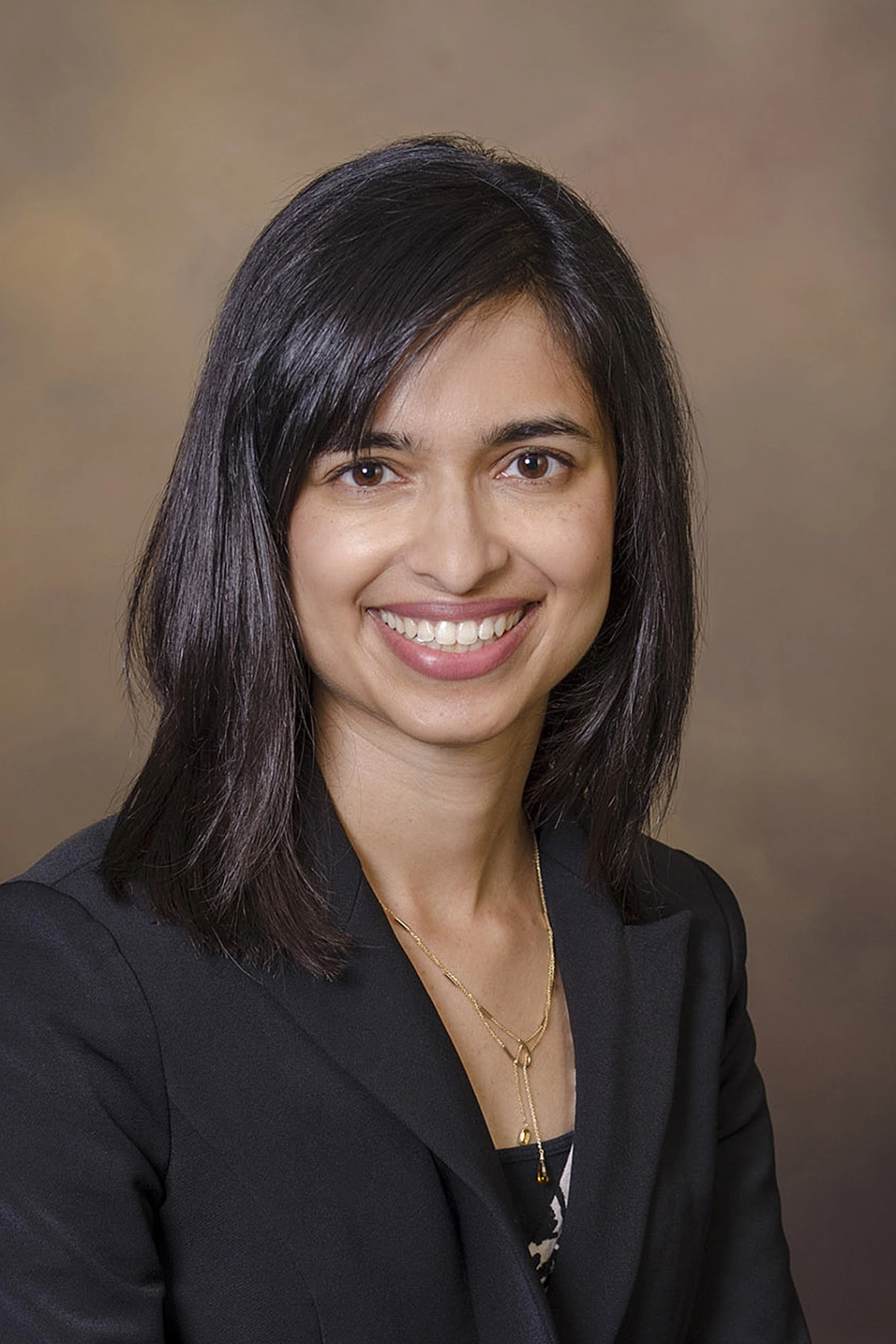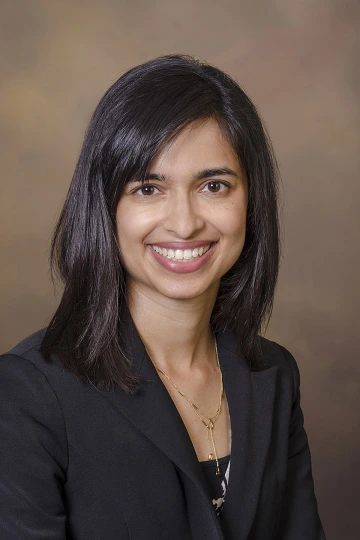Dr. Megha Padi Arrives from String Theory Background at Harvard to Expand Collaboration in Bioinformatics at UA Cancer Center

Megha Padi, PhD, harnesses the computational power of bioinformatics to learn more about cancer and how best to treat it — and empowers other cancer researchers to do the same.
Media Contact: Anna C. Christensen, 520-626-6401, achristensen@email.arizona.edu
April 23, 2018
TUCSON, Ariz. – The University of Arizona Cancer Center and Department of Molecular & Cellular

Biology are excited to welcome Megha Padi, PhD, to the Tucson campus, where she has been appointed director of the Bioinformatics Shared Resource at the UA Cancer Center and is an assistant professor of molecular and cellular biology. Dr. Padi came here from Boston, where she taught at Harvard Medical School and served as a postdoctoral fellow at the Dana-Farber Cancer Institute and the Harvard School of Public Health.
“We look forward to the high-impact science that will emerge from Dr. Padi’s lab,” said UA Cancer Center Director Andrew Kraft, MD. “Additionally, the entire Center will benefit from her expertise in bioinformatics and ability to link our scientists to important tools for their own research.”
“Dr. Padi is an amazing systems biologist who uses bioinformatics and computational biology to explore a host of cancer-related questions,” said Joyce Schroeder, PhD, director of the UA Cancer Center Metastatic Breast Cancer Initiative and professor and head of the UA Department of Molecular & Cellular Biology. “We are all very excited she is here.”
Physics to cancer research
Dr. Padi’s journey took a few twists and turns between 2009, when she received her doctorate in physics from Harvard, and her career in cancer research today.
“My PhD was in string theory, which combines gravity and quantum mechanics,” Dr. Padi explained. “It’s especially interesting in the context of black holes and other astronomical features that we’re not able to model properly with the tools we have in physics.”
The connection between black holes and cancer is not as tenuous as most people might think. Both can be studied with mathematical models, which use math to make inferences or predictions about events unable to be directly observed with the human eye.
“When I received my PhD, I realized I had been spending a lot of time building good mathematical models for phenomena that are really complex — but there wasn’t much data available to test your theories,” recalled Dr. Padi.
At the same time, the biosciences were producing an abundance of data, thanks to undertakings such as the Human Genome Project. The ability to sequence a person’s genome, the blueprint for life carried in every cell, provides clues about how genetic mutations can go haywire to cause cancer.
“I got really excited about all the genomics data coming out,” recalled Dr. Padi, reflecting on her transition from physics to cancer research.
Big data hits the big time
Dr. Padi arrived on the scene just in time to help wrangle the outpouring of difficult-to-analyze datasets produced by the genetic sequencing of cancer patients’ cells. She was eager to put her mathematical modeling skills to good use.
“Our genomes have 3 billion base pairs, which are like 3 billion letters,” explained Dr. Padi. Being able to read the genetic code can shed light on how the cells in our bodies can misfire to cause cancer. However, one person can’t read the genomes of thousands of individuals and tease out the differences associated with cancer.
“We have to have major computing power to sort through all of those sets of genomes and figure out the meaningful patterns between them,” she said. “Bioinformatics is the use of mathematics and computers to make sense of the large amounts of data coming out in biology.”
Dr. Padi hopes to use this approach to uncover evidence about cancer’s origins. For example, scientists can compare a tumor cell from a patient with breast cancer to a normal breast cell from the same patient, and see what genetic mutations are present in the tumor cell that are not present in the normal cell.
“You can sequence the genome in the normal cell, and you can do the same thing for the cancer cell,” Dr. Padi explained. Comparing the two can reveal the genetic mutations that give rise to cancer.
Identifying a genetic mutation, however, isn’t the same as identifying a cause of cancer. Cancer cells are especially prone to mutation, and while some of those mutations are harmful, others might just be random.
“These random mutation events are called passenger mutations,” Dr. Padi explained. There can be hundreds or thousands of “passenger mutations” for every mutation that actually helped cause a tumor.
“Figuring out which of those thousands of mutations were the ones that caused the tumor gets you at the causal mechanisms behind cancer, instead of getting bogged down in random statistical events,” Dr. Padi said.
Learning about cancer from viruses
Viruses are among the tiniest infectious agents that can cause disease, but despite their diminutive dimensions, they can pack a punch. Dr. Padi is especially interested in viruses that cause cancer, which they do by integrating into a cell’s genome to generate a “short cut” to tumor formation (tumorigenesis). She believes these viruses have much to teach us about cancer in general.
“Viruses can have 10 genes,” said Dr. Padi. For comparison, humans have about 30,000 genes and E. coli bacteria have around 4,000. To make up for their small genomes, “They’ve evolved to get those 10 genes to be as effective as possible.”
“Some viruses can initiate tumorigenesis through two genes,” Dr. Padi continued. With so few genes needed to trigger cancer, these viruses can light a path for researchers by revealing which mutations caused the cancer and which were just passenger mutations.
Dr. Padi cites the example of Merkel cell polyomavirus, which can lead to a rare but aggressive form of skin cancer.
“People with that kind of skin cancer who didn’t get infected by that virus [have] lots of genomic alterations. It’s a big mess, and it’s hard to wade through,” said Dr. Padi. “If you look at people who had the viral infection, they have very few genomic alterations. We can study viruses to uncover the minimal set of changes needed to cause cancer.”
The next step, said Dr. Padi, is to use that knowledge to figure out which molecular pathways should be targeted in order to treat different types of cancer.
Matching drugs to patients
Dr. Padi also uses computer algorithms to predict a patient’s response to a drug, based on the cancer’s unique genetic profile.
“We have millions of places in the genome where we differ from other people,” said Dr. Padi. “Those differences often cause changes in how we respond to treatment. But a person can’t read through a million letters and say, ‘You have these million letters, so you must take this drug and not the other one.’ We need computer science and informatics to sort through that.”
The computational power to sift through vast datasets of unique genomes has ushered in the era of precision medicine, which allows physicians to match patients to drugs that will work best on their particular disease.
“You want a doctor to know what the best treatments are for you,” said Dr. Padi. To do that, “we need mathematical models to predict which drug is appropriate for each person.”
Building bridges with the Bioinformatics Shared Resource
As the new director of the Bioinformatics Shared Resource, which provides research support to UA Cancer Center investigators, Dr. Padi is excited to bring faculty from diverse areas of campus together.
“There hasn’t been extensive interaction between the Cancer Center and some of the departments on main campus,” said Dr. Padi. “With the Bioinformatics Resource, we’ll be able to start building a lot of those bridges, which will be the flashpoint for creating new research.”
By linking UA Cancer Center researchers with faculty in other departments, like mathematics and computer science, Dr. Padi hopes to facilitate conversations and expand collaboration. She is bilingual in the lexicons of both math and biology, and hopes to use her “interpreter skills” to facilitate conversations and expand collaboration.
“We’re looking for people who have the ability to speak both languages,” Dr. Padi said. “Right now, there could be problems that are lying around unsolved, because the faculty member didn’t know someone else on campus was solving that same problem.”
The Bioinformatics Shared Resource will also help UA Cancer Center researchers access helpful information that is already out there, such as publicly available, open-source data.
“I’m a proponent of sharing everything that we have here with others, so that we can connect with the whole network of cancer researchers,” said Dr. Padi. “If we want to solve an extremely complicated problem like cancer, we need everyone to share what data they have, what computational methods they have, what ideas they have.”
While Dr. Padi is excited to “reconnect with my roots in physics” by exploring the astrophysical offerings on the UA campus, she has found that cancer research has its own rewards, even beyond intellectual satisfaction and professional partnerships.
“You can make a positive impact on human society,” said Dr. Padi, reflecting on the journey she has taken from physics to the biosciences. “It’s the best of all worlds for me, so I’ve been very happy with making that switch.”
About the University of Arizona Cancer Center
The University of Arizona Cancer Center is the only National Cancer Institute-designated Comprehensive Cancer Center with headquarters in Arizona. The UArizona Cancer Center is supported by NCI Cancer Center Support Grant No. CA023074. With its primary location at the University of Arizona in Tucson, the Cancer Center has more than a dozen research and education offices throughout the state, with more than 300 physicians and scientists working together to prevent and cure cancer. For more information: cancercenter.arizona.edu (Follow us: Facebook | Twitter | YouTube).



